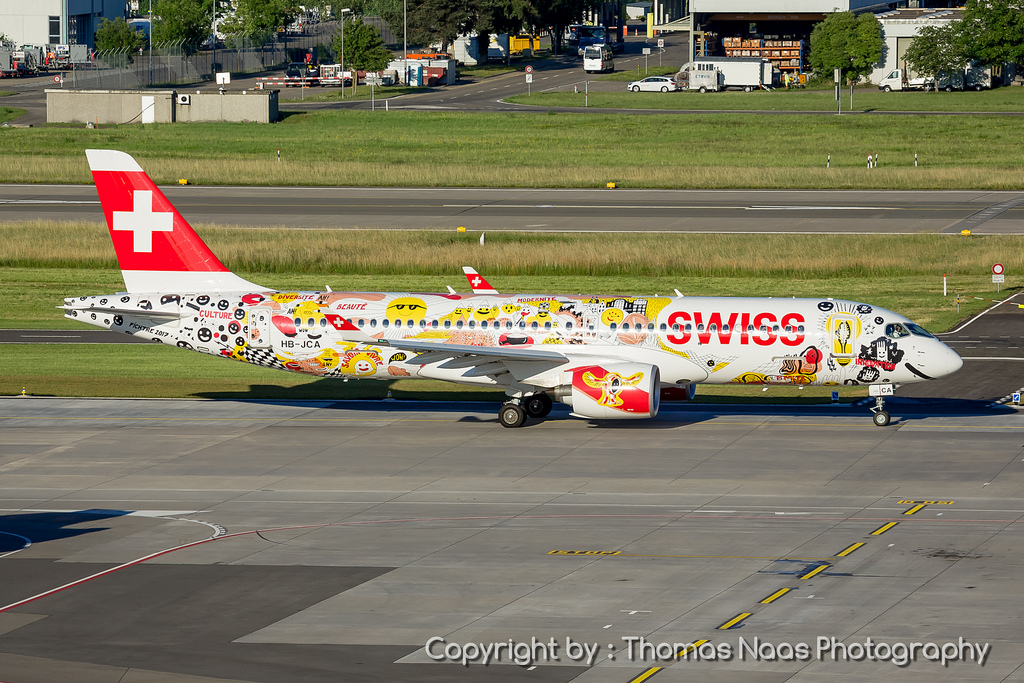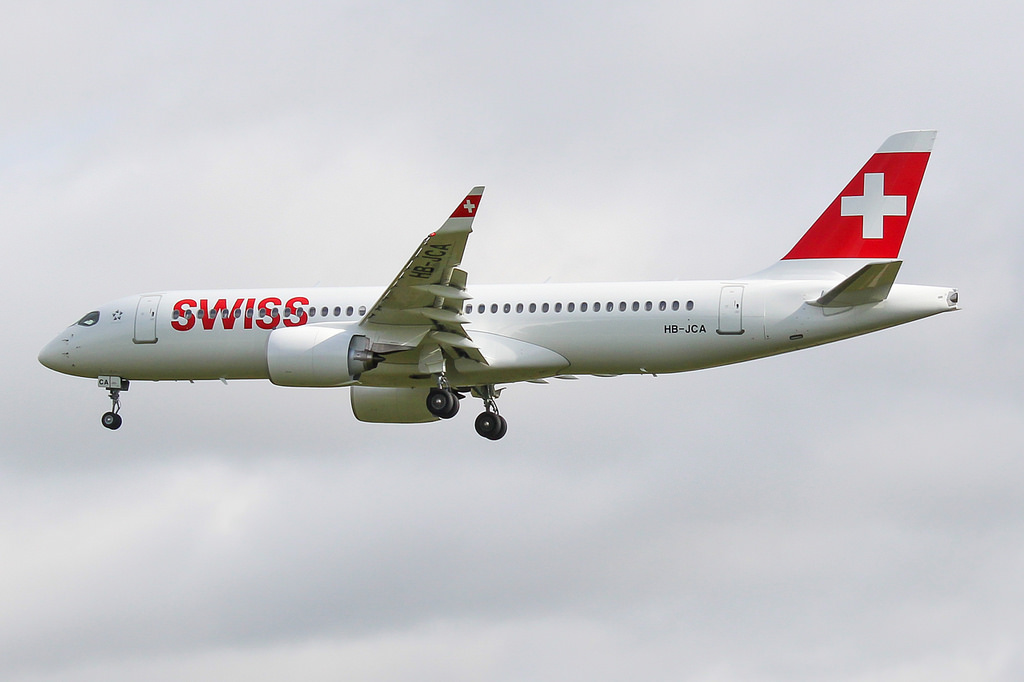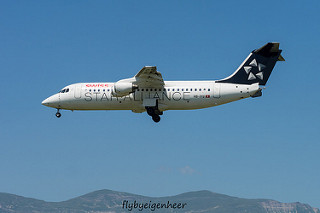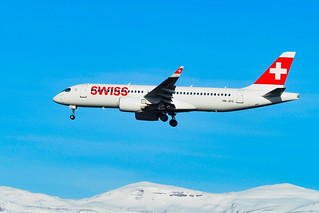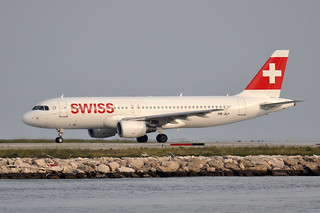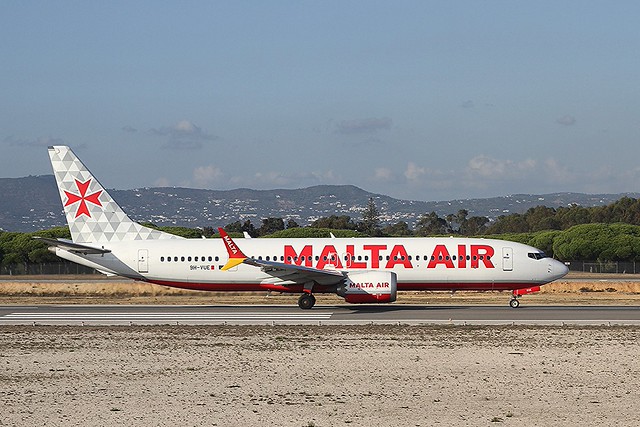Swiss BCS3 near Geneva on Sep 16th 2019, uncontained engine failure
Last Update: May 4, 2022 / 17:00:37 GMT/Zulu time
Incident Facts
Date of incident
Sep 16, 2019
Classification
Incident
Airline
Swiss
Flight number
LX-358
Departure
Geneva, United Kingdom
Destination
London Heathrow, United Kingdom
Aircraft Registration
HB-JCA
Aircraft Type
Airbus A220-300
ICAO Type Designator
BCS3
The airline reported the aircraft returned to Geneva due to an irregularity on one of the engines. The exact cause of the problem is being investigated by maintenance.
On Sep 19th 2019 the NTSB reported the aircraft sustained a left engine (PW1524G) failure just prior to reaching the top of climb at FL350. The crew worked the related checklists, shut the engine down and returned to Geneva. A post flight inspection revealed a hole in the low pressure compressor case and a separated low pressure compressor stage 1 rotor. There were no injuries. The NTSB accepted the delegation of the investigation by the French BEA and the Swiss SUST. The occurrence is rated an incident and is being investigated by the NTSB.
The FAA released an Air Worthiness Directive 2019-19-11 requiring following actions on Pratt & Whitney Models PW1519G, PW1521G, PW1521GA, PW1524G, PW1525G, PW1521G-3, PW1524G-3, PW1525G-3, PW1919G, PW1921G, PW1922G, PW1923G, and PW1923G-A turbofan engines that have accumulated fewer than 300 flight cycles:
(1) Within 50 flight cycles from the effective date of this AD, and thereafter at intervals not to exceed 50 flight cycles until the engine accumulates 300 flight cycles, borescope inspect each LPC inlet guide vane (IGV) stem for proper alignment.
(2) Within 50 flight cycles from the effective date of this AD, and thereafter at intervals not to exceed 50 flight cycles until the engine accumulates 300 flight cycles, borescope inspect the LPC R1 for damage and cracks at the following locations:
(i) The blades tips;
(ii) the leading edge;
(iii) the leading edge fillet to rotor platform radius; and
(iv) the airfoil convex side root fillet to rotor platform radius.
(3) As the result of the inspections required by paragraphs (g)(1) and (2) of this AD, before further flight, remove and replace the LPC if:
(i) An IGV is misaligned; or
(ii) there is damage on an LPC R1 that exceeds serviceable limits; or
(iii) there is any crack in the LPC R1.
The FAA argued the AD is necessary:
The FAA received reports of two recent IFSDs on PW PW1524G-3 model turbofan engines. The first IFSD occurred on July 25, 2019 and the second IFSD occurred on September 16, 2019. These IFSDs were due to failure of the LPC R1, which resulted in the LPC R1 releasing from the LPC case and damaging the engine. LPC rotor failures historically have released high-energy debris that has resulted in damage to engines and airplanes (see Advisory Circular (AC) 39-8, “Continued Airworthiness Assessments of Powerplant and Auxiliary Power Unit Installations of Transport Category Airplanes,” dated September 8, 2003, available at rgl.faa.gov). Although these IFSDs occurred on PW PW1524G-3 model turbofan engines, the FAA is including PW PW1900 engines in the applicability of the AD because similarities in type design make these engines susceptible to the same unsafe condition as PW PW1500 engines. This condition, if not addressed, could result in uncontained release of the LPC R1, in-flight shutdown, damage to the engine, damage to the airplane, and loss of control of the airplane. The FAA is issuing this AD to address the unsafe condition on these products.
According to this FAA AD the root causes of this and an earlier occurrence, see Incident: Swiss BCS3 near Paris on Jul 25th 2019, engine shut down in flight are related.
On Mar 31st 2020 the FAA released another Airworthiness Directive AD-2020-07-02 arguing:
The FAA has received reports of four instances of IFSDs occurring on the affected model turbofan engines since 2019.
In response to the two IFSDs that occurred in July and September 2019, and in response to ongoing investigations of these IFSDs, the FAA issued AD 2019-19-11 (84 FR 50719, September 26, 2019), to perform inspections of the LPC R1 to prevent failures. The FAA subsequently superseded AD 2019-19-11, issuing AD 2019-21-11 (84 FR 57813, October 29, 2019) in response to another IFSD and to expand the population of affected engines that needed inspection of the LPC R1. Since the effective date of AD 2019-21-11, another IFSD occurred in February 2020. Analysis by the manufacturer determined that the LPC vane schedules were putting the engine in a condition to experience an acoustic resonance that damages the LPC R1, which then leads to LPC R1 failure. In response, the manufacturer updated the EEC FADEC software to improve vane scheduling to avoid acoustic resonance.
This condition, if not addressed, could result in uncontained release of the LPC R1, damage to the engine, and damage to the airplane. The FAA is issuing this AD to address the unsafe condition on these products.
The four mentioned occurences are: Incident: Swiss BCS3 near Paris on Jul 25th 2019, engine shut down in flight, Incident: Swiss BCS3 near Geneva on Sep 16th 2019, uncontained engine failure, Incident: Swiss BCS3 near Paris on Oct 15th 2019, engine shut down in flight and Incident: Baltic BCS3 near Bordeaux on Feb 12th 2020, uncontained engine failure.
On May 4th 2022 the NTSB released their final report (associated docket) concluding the probable causes were:
A No. 1 (left) engine low pressure compressor (LPC) stage 1 integrally bladed rotor (IBR) separation due to a high cycle fatigue crack (HCF) that originated at the runout of an airfoil leading edge root radius.
The HCF crack developed because of a mechanically coupled LPC stage 3 and stage 1 IBR mode excitation and blade flutter response. The excitation was driven by an acoustic tone generated by turbulent airflow passing over the 2.5 bleed valve duct cavity while the engine was operating at high speeds in specific flight conditions.
A primary contributor to the failure mode was an electronic engine control (EEC) software update that changed the LPC vane schedule and increased the likelihood of LPC stage 1 IBR blade flutter onset within the engine operating range.
The NTSB analysed:
Computer modeling, component testing, and instrumented flight tests were conducted to identify the root cause of the failures. The testing identified that at specific engine operating conditions an acoustic tone was generated by the 2.5 bleed valve located immediately aft of LPC stage 3 rotor that excited coupled LPC stage 3 and stage 1 IBR rotor modes. The sound waves from the acoustic tone excited a LPC stage 3 IBR 1st bending mode that then mechanically transferred through the LPC module and excited a coupled LPC stage 1 IBR stiffwise bending mode. The acoustic coincidence and blade flutter response created LPC stage 1 IBR blade stress levels that exceeded material limits and resulted in leading edge blade root crack formation and subsequent IBR fracture. Factors that contributed to the acoustic coincidence included an electronic engine control (EEC) software revision that altered the LPC variable inlet guide vane (IGV) schedule and tighter LPC IBR blade tip clearance due to low time on the engine.
There were three PW1524G-3 and one PW1521G-3 LPC stage 1 IBR separations between July 25, 2019 and February 12, 2020, that occurred on multiple operators. The incident detailed in this investigation was the second of the four PW1500G series LPC stage 1 IBR failures. The engine parameters at the time of the four LPC stage 1 IBR failures and the resulting engine damage were consistent in each of the events.
The NTSB reported following corrective actions were taken:
Corrective actions were released by P&W, Federal Aviation Administration (FAA), Airbus Canada, and Transport Canada to reduce the likelihood of additional events. A recurrent BSI of the LPC stage 1 IBR was mandated, and the inspections identified two additional LPC stage 1 IBR crack findings in the fleet. An engine low rotor speed (N1) restriction above FL290 was implemented to reduce the likelihood of mode excitation. EEC software update V2.11.9 was released to revert the LPC vane schedule back to the original vane schedule that was programmed prior to the LPC stage 1 IBR fractures. Another EEC software update, V2.11.10, was later released to automate the 95.2% N1 speed limit at altitudes above FL290. P&W has also begun installation of a redesigned 2.5 bleed valve in the fourth quarter of 2021 to provide adequate frequency separation from the coupled LPC response that is the driver of the LPC stage 1 IBR separations.
Aircraft Registration Data
Incident Facts
Date of incident
Sep 16, 2019
Classification
Incident
Airline
Swiss
Flight number
LX-358
Departure
Geneva, United Kingdom
Destination
London Heathrow, United Kingdom
Aircraft Registration
HB-JCA
Aircraft Type
Airbus A220-300
ICAO Type Designator
BCS3
This article is published under license from Avherald.com. © of text by Avherald.com.
Article source
You can read 2 more free articles without a subscription.
Subscribe now and continue reading without any limits!
Read unlimited articles and receive our daily update briefing. Gain better insights into what is happening in commercial aviation safety.
Send tip
Support AeroInside by sending a small tip amount.
Related articles
Swiss BCS3 near Friedrichshafen on Jul 7th 2025, fault messages in cockpit, smoke in cabin
A Swiss International Airlines Bombardier C-Series CS-300, registration HB-JCA performing flight LX-1413 from Belgrade (Serbia) to Zurich…
Swiss BCS3 near Geneva on Jun 20th 2017, generator trouble
A Swiss Global Airlines Bombardier CS300, registration HB-JCA performing flight LX-528 from Geneva (Switzerland) to Nice (France) with 105…
Swiss BCS3 near London on Jun 18th 2017, generator trouble
A Swiss Global Airlines Bombardier CS300, registration HB-JCA performing flight LX-352 from Geneva (Switzerland) to London Heathrow,EN (UK) with 54…
Swiss RJ1H enroute on Sep 3rd 2016, fumes in cockpit and cabin
A Swiss Global Airlines Avro RJ-100, registration HB-IYU performing flight LX-2813 from Geneva to Zurich (Switzerland) with 88 passengers and 4 crew,…
Swiss BCS3 near Zurich on Jul 24th 2022, loss of cabin pressure
A Swiss Bombardier C-Series CS-300, registration HB-JCG performing positioning flight LX-5141 from Ibiza,SP (Spain) to Zurich (Switzerland) with just…
Swiss BCS3 near Paris on Oct 15th 2019, engine shut down in flight after uncontained failure
A Swiss International Airlines Bombardier C-Series CS-300, registration HB-JCC performing flight LX-359 from London Heathrow,EN (UK) to Geneva…
Swiss BCS1 near Geneva on Feb 22nd 2022, brakes problem
A Swiss Bombardier C-Series CS-100, registration HB-JBE performing flight LX-1082 from Geneva (Switzerland) to Frankfurt/Main (Germany), was enroute…
Swiss A320 at Zurich on Jun 13th 2021, fumes in cockpit
A Swiss Airbus A320-200, registration HB-JLP performing flight LX-967 from Berlin (Germany) to Zurich (Switzerland) with 19 passengers and 7 crew,…
Newest articles
Malta B38M at Krakow on Dec 8th 2025, sun visor temporarily shuts engine down
An Air Malta Boeing 737-8 MAX on behalf of Ryanair, registration 9H-VUE performing flight FR-3505 from Krakow (Poland) to Milan Bergamo (Italy), was…
Hokkaido AT42 at Okushiri on Dec 16th 2025, problems with left aileron
A Hokkaido Air System Avions de Transport Regional ATR-42-600 on behalf of JAL Japan Airlines, registration JA13HC performing flight JL-2891 from…
Subscribe today
Are you researching aviation incidents? Get access to AeroInside Insights, unlimited read access and receive the daily newsletter.
Pick your plan and subscribePartner

ELITE Simulation Solutions is a leading global provider of Flight Simulation Training Devices, IFR training software as well as flight controls and related services. Find out more.
SafetyScan Pro provides streamlined access to thousands of aviation accident reports. Tailored for your safety management efforts. Book your demo today
AeroInside Blog
Popular aircraft
Airbus A320Boeing 737-800
Boeing 737-800 MAX
Popular airlines
American AirlinesUnited
Delta
Air Canada
Lufthansa
British Airways
